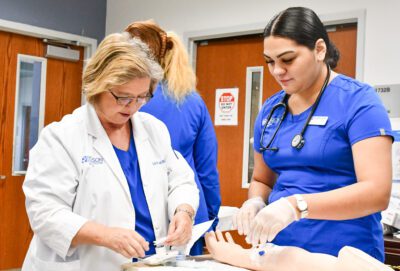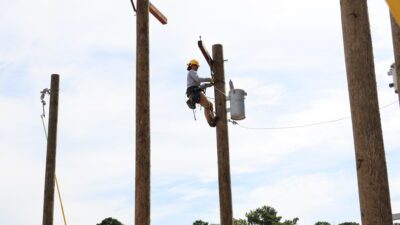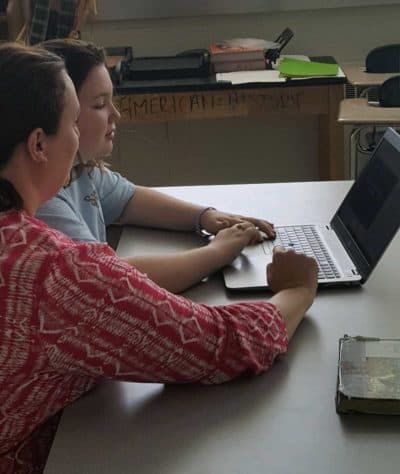
The governor’s Council on Workforce and Apprenticeships recently held its first meeting since releasing a report in late June that outlines 11 workforce development goals. The goals seek to “enhance the connections between jobseekers, learners, and employers across the state” and each include a target to be achieved within the next four years.
In early August, the council split into four subcommittees, each charged with drafting strategies to achieve specific goals:
- Education and Credential Attainment – Building Pathways to Postsecondary Success: Goals 1, 2, and 3
- Work-Based Learning and Apprenticeships: Goals 4, 5, and 10
- Employer Engagement: Goals 6, 7, and 8
- Governing and Aligning a Future-Ready Workforce: Goals 9 and 11
As the council’s subcommittees consider what those strategies should be, the August meeting included a presentation from the National Governors Association (NGA) that provided context on the federal policy landscape and strategies other states are using to achieve similar goals.
![]() Sign up for Awake58, our newsletter on all things community college.
Sign up for Awake58, our newsletter on all things community college.
The federal workforce policy landscape
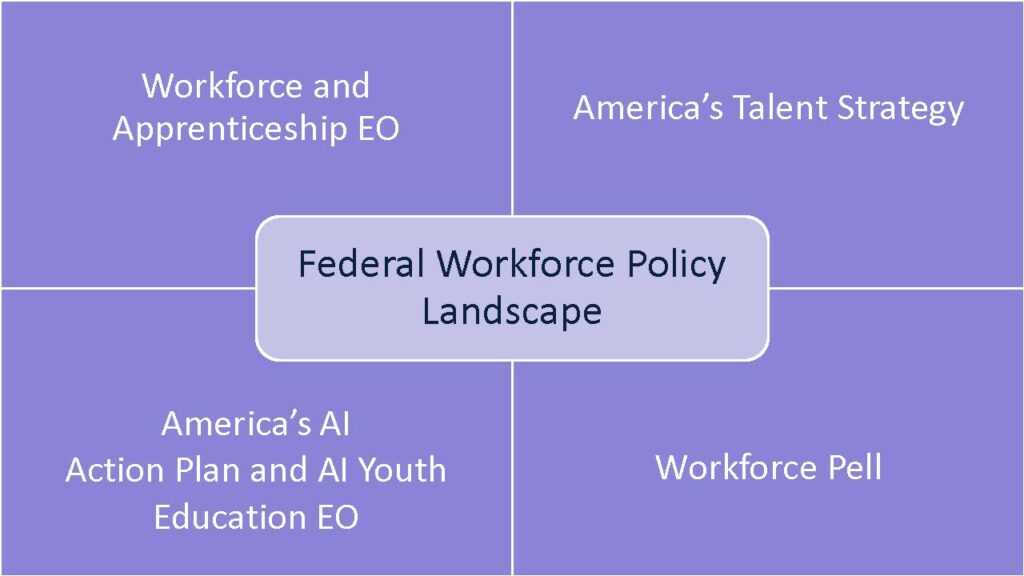
Sophia Yager, senior policy analyst with the Workforce Development and Economic Policy Program at the NGA’s Center for Best Practices, began by sharing an overview of recent federal actions that are related to workforce policy:
- Workforce & Apprenticeship Executive Order: On April 23, 2025, President Donald Trump issued an executive order titled, “Prepare Americans for High-Paying Skilled Trade Jobs of the Future.” Yager noted that this executive order prioritizes ways to reform and streamline federal workforce and education programs, particularly as it relates to data and performance. It also includes a goal of surpassing 1 million new active apprentices, in part by expanding and improving the efficiency of Registered Apprenticeships.
- America’s Talent Strategy: Released on Aug. 12, 2025, and required by the aforementioned executive order, America’s Talent Strategy details the federal government’s cross-agency approach to workforce development. The five pillars of the strategy include: demand-driven strategies, worker mobility, integrated systems, accountability, and flexibility and innovation. Yager said the strategy includes expanding registered apprenticeships to new occupations and industries, consolidating and streamlining federal workforce and education programs, and using federal waiver authorities to increase flexibility and innovation within federal workforce and education programs.
- America’s AI Action Plan and AI Youth Education Executive Order: On April 23, 2025, Trump issued an executive order titled, “Advancing Artificial Intelligence Education for American Youth,” and in July 2025, the White House released “America’s AI Action Plan.” Yager said that both actions reflect that the federal government is looking for opportunities to embed AI as a core objective of federal workforce education and programming. For example, the executive order directs the secretary of labor to increase participation in AI-related registered apprenticeships, including by encouraging states to use funding under the Workforce Innovation and Opportunity Act to develop AI skills and support work-based learning opportunities within occupations that use AI.
- Workforce Pell: The federal budget reconciliation bill, signed into law by Trump on July 4, 2025, includes provisions that will allow students in short-term workforce training programs (between 8-15 weeks) to use Pell Grants for tuition, fees, and other expenses. Before the legislation, Pell Grants could only cover the costs for curriculum-based programs lasting 15 weeks or more. Yager said that the statute charges governors and state workforce boards with defining eligibility criteria for Workforce Pell Grants and that funds can be used beginning July 1, 2026.
Read more
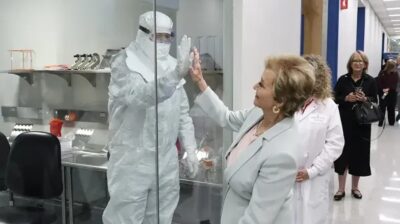
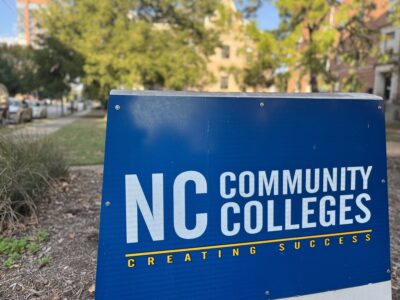
Strategy suggestions and examples from other states
Yager then shared potential strategies for the council to consider for Goals 1-8 and examples from other states that have implemented similar efforts, captured in the slides below.
Goal 1: Ensure 2 million North Carolinians ages 25-44 will have earned an industry-valued credential or degree.
Examples from other states:
Goal 2: By graduation, every high school student will have completed coursework that results in transferable credit or credential/certifications in preparation for the postsecondary pathway of their choice, such as dual enrollment, Career & Technical Education (CTE) concentrator, Junior Reserve Officers’ Training Corps (JROTC), Advanced Placement/International Baccalaureate, and work-based learning courses.
Examples from other states:
- Blueprint for Maryland’s Future | Pillar 3: College + Career Readiness
- Montana 406 Jobs Plan | Executive Order | Press Release
Goal 3: For graduating high school students, increase postsecondary enrollment, employment, or enlistment in the military within 12 months of high school graduation.
Examples from other states:
Goal 4: Double the number of registered apprentices.
Examples from other states:
Goal 5: Increase participation in work-based learning.
Examples from other states:
- Nevada Credit for Work-Based Learning | 2023 legislation
- Montana STARS Act | 2025 legislation
- New York Partnership for Inclusive Internship
Goal 6: Engage 50,000 employers to partner with the governor’s Council on Workforce and Apprenticeships on achieving its goals.
Examples from other states:
- Maryland Governor’s Apprenticeship Pledge
- North Dakota Regional Workforce Impact Program
- Indiana Executive Orders
Goal 7: Establish and expand coordinated partnerships between education and workforce agencies and employers to increase alignment of resources to better address current and projected employer needs. Partnerships will result, on an annual basis, in the identification of local industry-valued training across the education continuum, shared planning for educational courses to meet these training needs, and increased use of available federal and state funds to support training in these programs.
Examples from other states:
Goal 8: Create statewide sector-based workforce development strategies for at least three key industries, including, but not limited to, advanced manufacturing, education, and health care.
Examples from other states:
Other goals
Not discussed in Yager’s presentation, the final three goals are:
- Goal 9: Develop a plan to integrate AI skills development into sector-based strategies and work-based learning in key industries to build a future-ready workforce.
- Goal 10: Reduce state government vacancy rate to 15%.
- Goal 11: Launch a coordinated statewide public outreach effort to broaden awareness and participation in workforce development programs by employers, learners, jobseekers, and incumbent workers, with an emphasis on reaching under-tapped talent pools like rural communities, veterans and their families, individuals with disabilities, and the justice-involved.
Looking ahead
The council will meet next on Thursday, Nov. 6 in Raleigh. Until then, subcommittees will work to draft strategies to achieve each goal that are time-limited and measurable.
Then, the council will meet virtually in early December before submitting a report that outlines strategies to achieve each goal to Gov. Josh Stein by Dec. 15. All goals are on a four-year timeline and annual progress reports will be submitted each December starting in 2026.
Previous agendas and upcoming meeting information can be found here. The council encourages community members to submit comments on the workforce development issues that matter to them via this form.
Recommended reading
